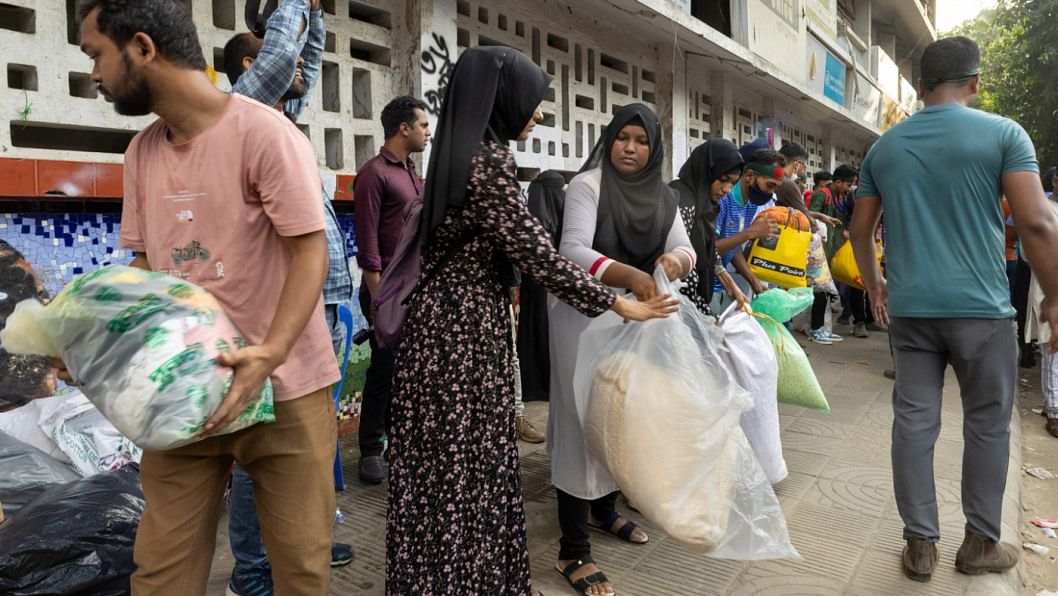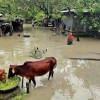It has been an eye-opener for the nation since the cascading effect left by the recent mass uprising. From offering drinking water to a rickshaw-puller peddling injured victims to hospitals free of charge, it cemented the idea that people are willing to save lives beyond just caring about their brethren. After the revolution, we faced yet another disaster caused by the torrential flood. Being one of the worst flood crises in decades, everyday citizens of Bangladesh have displayed, yet another, extraordinary level of solidarity and resourcefulness. Individuals, groups, religious institutions, and the armed services have all contributed to the continuing relief operations around the nation, assisting the millions of people impacted by the floods.

Grassroots efforts and community support
Local communities have been organising relief activities in numerous locations on their own initiative. Contributing food, water, and clothing was only the tip of the positivity iceberg; the youth have even built improvised rafts to rescue trapped people. When it came to cities and streets, people from all walks of life formed long queues to donate whatever they could to help the flood-affected victims.
To put things into perspective, members of the third-gender community, children, and even homeless people have been seen to donate whatever they could.
Role of the student community
At Dhaka University's TSC area, a massive relief operation is underway, with students and volunteers working tirelessly to collect, sort, and package essential supplies for flood-affected areas.
The TSC cafeteria and games room are overflowing with donations, ranging from food and medicine to clothing and water. Spilling out onto the field where rows of relief packages stretch like a sea of hope. The entire campus has become a hub of unity and purpose, with people from all walks of life contributing.
As volunteers work in shifts, the operation continues to grow, with over 1 crore 24 lakh taka collected in cash donations alone.
The role of religious institutions
The involvement of religious institutions in the relief operations has been one of the most touching parts. Temples and other religious institutions have come forward with financial support, at times even taking money meant for religious festivities and rerouting it. This act of selflessness demonstrates the community's dedication to helping people in need despite differences in religion or culture.
Military involvement: A critical lifeline
The Army, Navy, and Air Force of Bangladesh have been instrumental in the flood relief efforts. Several of the hardest-hit districts, including Feni, Chattogram, Cumilla, Noakhali, Sunamganj, and Habiganj, have seen the army's deployment. There, they have carried out relief distribution, medical attention, and rescue operations.
The army has played an especially important role in regions where rising water levels have restricted civilian access. Army medical personnel have been sent to certain locations to provide vital medical care to flood victims.
The Bangladesh Navy has also played a significant role, especially when it comes to saving lives in places where boats are the only practical mode of transportation. The Navy, for instance, has been actively involved in rescue efforts and the provision of basic supplies in Feni, working nonstop to reach outlying settlements.
The Bangladesh Air Force has also contributed airborne support, which has improved the efficiency of relief activities and allowed for a more accurate assessment of the damage. The military's multifaceted strategy has made sure that assistance reaches even the most isolated locations, where the need is frequently highest.
The Bangladesh Army furthered the continuing relief efforts by paying a day's salary from all ranks to the Chief Advisor's Relief Fund as a show of solidarity.
A unified response
The way Bangladesh responded to the floods in 2024 shows how strong togetherness can be in times of adversity. The national defence forces, religious organisations, and local communities have worked together in a way that is given as examples in books. This cohesive strategy serves as a potent reminder of the value of sticking together in the face of difficulty in addition to demonstrating the resiliency of the Bangladeshi people.
As the nation embarks on the protracted process of recuperation and the floods start to retreat, the joint endeavours of all those engaged in the relief efforts will be cherished as evidence of the resilience of the Bangladeshi people and their community.









Comments